When we think of farming poultry, it’s common to think of chickens and maybe ducks, but you might be surprised to learn that geese have actually been extremely popular as livestock for ages.
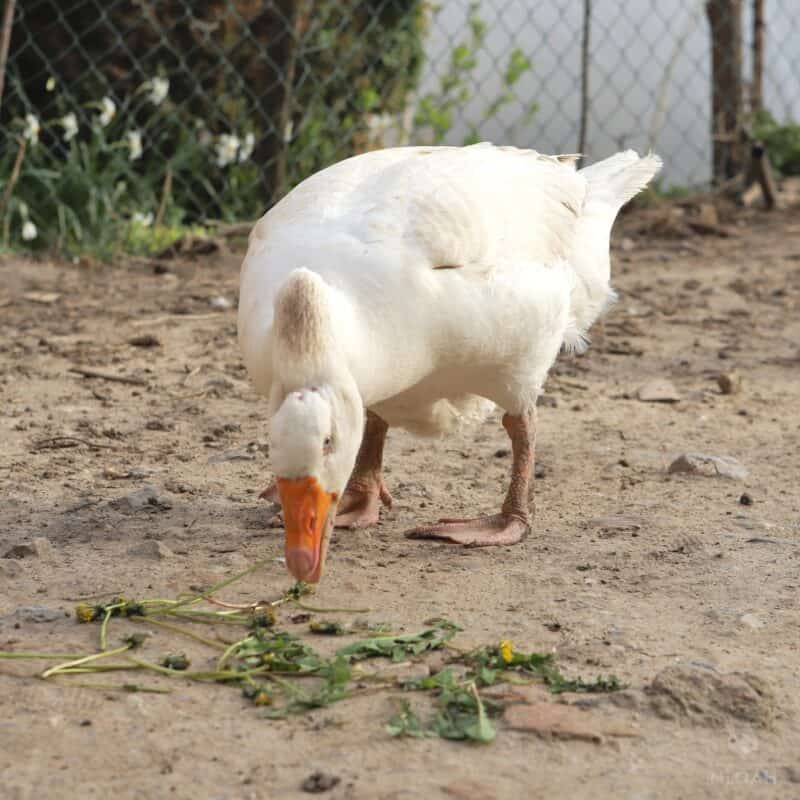
Although they don’t lay as many eggs as chickens or ducks, they lay large ones and since these birds are so big themselves they can produce a lot of meat when it is time to slaughter.
But whatever intentions you have for a flock on your homestead, if you love the look of pure, shining white feathers you’ll be happy to know that there are many species of wild and domestic geese that are all white in color, or very nearly so.
Or perhaps you’re just looking for some interesting specimens when you’re out bird-watching by the lake.
Whatever the case, I’ll be bringing you a list of 12 white goose breeds to know and telling you a little bit about each of them.
All-White Goose Breeds
The following breeds of geese are pure white except for their feet, their bills and their eyes. Although they might have the slightest shading on their feathers at various parts of their body, it does nothing to disrupt the impression that all of these geese are as white as snow.
1. Slovak White
A legacy, or heritage breed of goose, that hails from Slovakia, as the name suggests, these geese are distinguished by their bright or slightly off-white feathers that have a ruffled, almost downy appearance.
The Slovak White is a medium goose that will reach between 13 and 16 pounds (6 to 7 kilograms), with males being larger as is typical.
Long raised for meat and also for their livers, it is actually those fluffy feathers that were the chief commodities owing to their excellent softness and insulating properties.
Regrettably, this is one domestic goose that is critically endangered, and there are only thought to be a few hundred left…
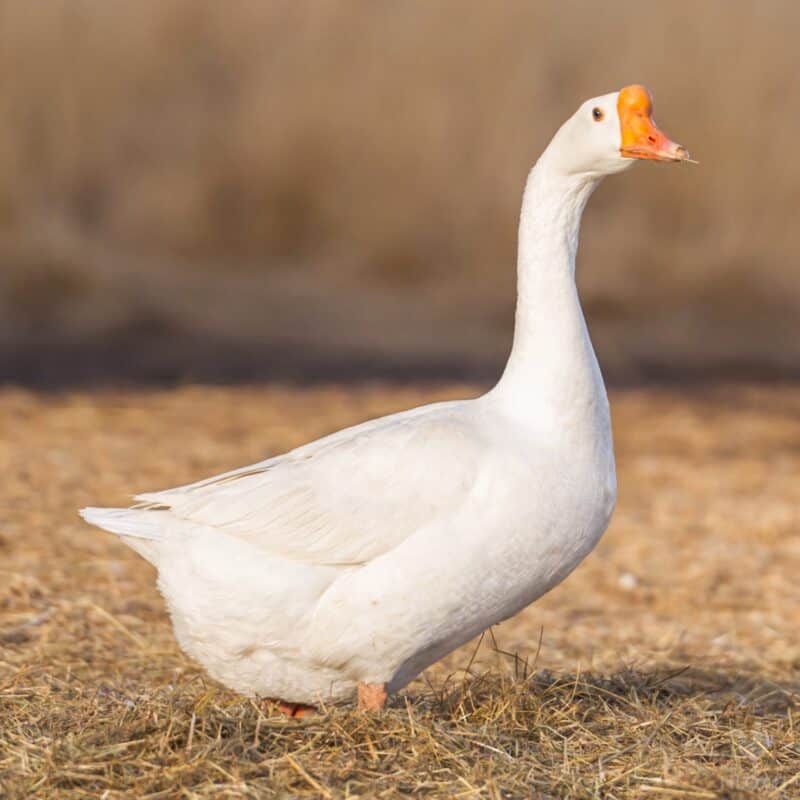
2. Chinese
There are a few color morphs of the Chinese goose, and they can be brown, tan, or a pure, dazzling white.
Of course, we are talking about the white version today! Whatever color feathers these impressively large specimens have, all have an extremely obvious protruding orange knob on their forehead (located just above the base of the beak).
Compared to other breeds of goose kept domestically, these are among the very best egg layers, and it’s not uncommon for females from certain lines to lay more than 80 eggs every year.
That’s not a lot by chicken standards, but that’s a ton by goose standards! If eggs are what you want from your geese, you won’t beat a Chinese.
3. Czech
Domestic geese that are known for being superb foragers with a highly varied diet, and also quite noisy, the Czech is a smaller breed of goose that has a brilliant, pure white feathers from tip to tail.
Typically raised for meat, these birds are not great egg layers, with females topping out at a maximum of around 30 per year.
Also, interestingly, these geese have a sub-variety that has a crest if you prefer geese that have a cool haircut!
Czech geese tend to be very popular with keepers who are inexperienced and don’t mind the noise because they tend to be very friendly and energetic.
They’re always happy to see you, and watching their antics as they go about their day is worth the price of admission.
4. African
The African goose is another breed that comes in one of several colors, but naturally it is on this list because they have an all-white variety.
The African is notable for looking very similar to the Chinese goose featured above, and they even has a similar protrusion at the base of its bill.
Some ornithologists and goose fanciers even speculate they are directly descended from the Chinese.
But the African is quite popular as a meat bird as opposed to egg-laying, since it grows even larger than Chinese and is nowhere nearly as prolific a layer: Most females max out at around 35 eggs per year.
But if you want large and hardy geese that are easier to handle, white Africans might be just the ticket.
5. Emden
Certainly the largest and likely the oldest of the common domestic breeds, an Emden goose will stand on average at least 3 feet tall from foot to crown, and several spectacular male specimens have stood quite a bit taller than that.
And with great height comes great heft, as these beefy birds can wait anywhere from 20 to 31 pounds!
The Emden is typically kept for its meat or else for its liver, though it’s also raised for its feathers. They are a natural white color all over, although the chests, flanks and underside may have a dusty tan or gray tint to them.
6. West of England
The West of England, as you might have guessed, originates from England or at the very least the United Kingdom according to the best guesses of historians on the matter.
A utility breed that’s typically raised as a meat bird but also for eggs since highly productive females can lay about 50 a year.
These geese are also notable for being one of the very few autosexing domestic goose breeds, as males and females have distinct coloration: males are pure white with orange beaks, while females are mostly white with large tan-gray patches and beaks that are more pinkish in color.
7. Sebastopol
An older domestic breed that has been known since at least the mid-19th century in Europe, Sebastopols are most notable for their unique “curlicue” feathers that cover their bodies behind the breast and neck.
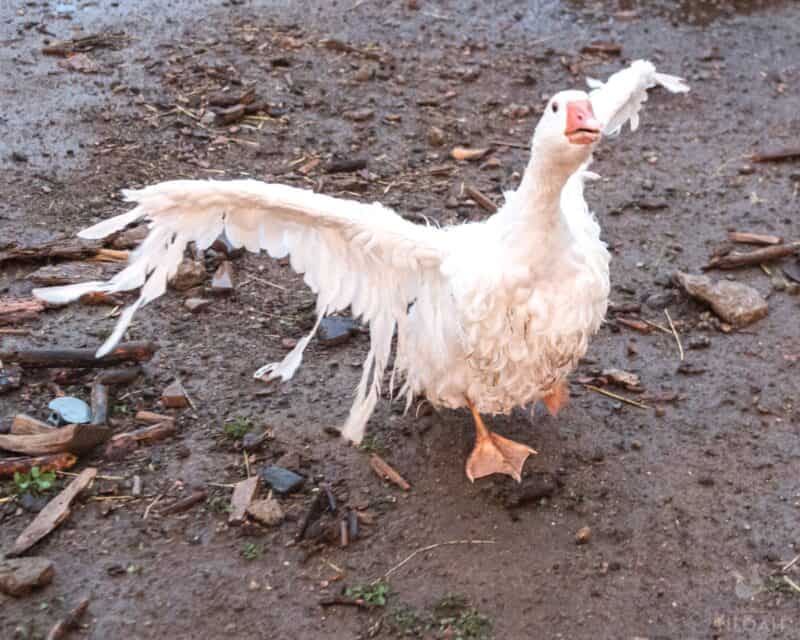
This gives them a puffy almost theatrical appearance, but these birds are also surprisingly decent layers and occasionally raised for meat (although today they persist mostly as a curiosity or showbird).
These unique geese are pure white all over except for their eyes, beaks and feet. The ruffled appearance sometimes makes them look faintly bluish or gray depending on the lighting, but they are in actuality white all over.
Mostly or Part-White Geese
The goose breeds on the second half of our list are distinguished by being mostly white all over with patches, accents or other markings of varying colors.
If you want a sparkling white goose with a little bit of character, one of these breeds might serve.
8. Pomeranian
A chunky domestic breed that is typically reared for meat, Pomeranians are known for being extremely vocal, heavy for their size, and also decent egg layers with females cranking out around 30 to 40 eggs each and every year.
These geese are mostly white all over, but their heads, necks, thighs and backs are covered by steel gray to brown-gray feathers giving them a sporty, alert appearance.
Be careful if you are a first-time keeper, because Pomeranians have a reputation for aggressiveness towards people!
9. Snow Goose
One of the most plentiful geese species out there, and found around the world with a name like snow geese you know these guys have got to be all white, right?
Surprisingly, no, as snow geese have thin, black feathers at the ends of their wings and on their tails. It sort of looks like a spoiler!
Also, snow geese are most notable for migrating and living in absolutely immense flocks, and it’s not uncommon to see them wipe out edible plant matter in an area where they settle down for a while.
10. Roman Tufted
A multi-purpose domestic breed originating from Italy and also found in the wild, the Roman Tufted is small and delicate but a goose that matures very quickly.
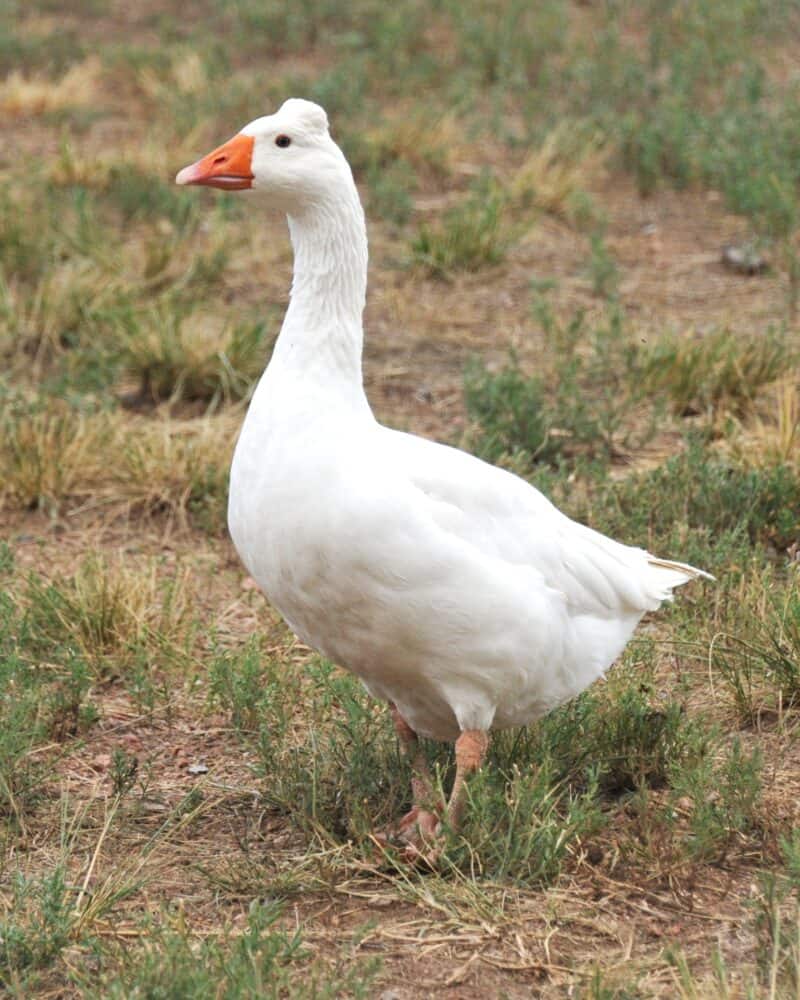
Considering they produce an ample amount of high-quality meat and can also lay 40 eggs or more every year, this makes them one of the most productive and reliable species for homesteaders and farmers.
This is also a breed notable for being mostly white and sometimes all white, although it’s more common to find them with buff, fawn or gray patches. They also have a distinct crown of feathers on their heads, hence the name.
11. American Buff
A relatively recent domestic breed first acknowledged around the middle part of the 20th century by the American poultry association, the American Buff is typically kept for the production of meat and eggs.
However, this is becoming less and less common as this breed edges towards extinction. Sad to say, but they are rarely encountered anymore.
That is a shame because these geese are extremely good-natured, quite large and very beautiful, with pure white undersides and lower breasts that are topped by a variety of other colors ranging from off-white and buff to tan or even speckled brown.
12. Ross’s Goose
Ross’s Goose, or I guess Ross’s Geese, are a wild species that is sometimes mistaken for snow geese, that it often associates with.
As you might have guessed from that comparison, this is another pure, blinding white goose that has small black wingtips and tail feathers giving it a dramatic appearance.
Especially common in the middle part of the northern United States and all the way up through Canada and the Arctic Circle, Ross’s goose was once an occupant of the endangered species list thanks to overhunting, but conservation efforts have seen wild populations rebound in grand fashion.
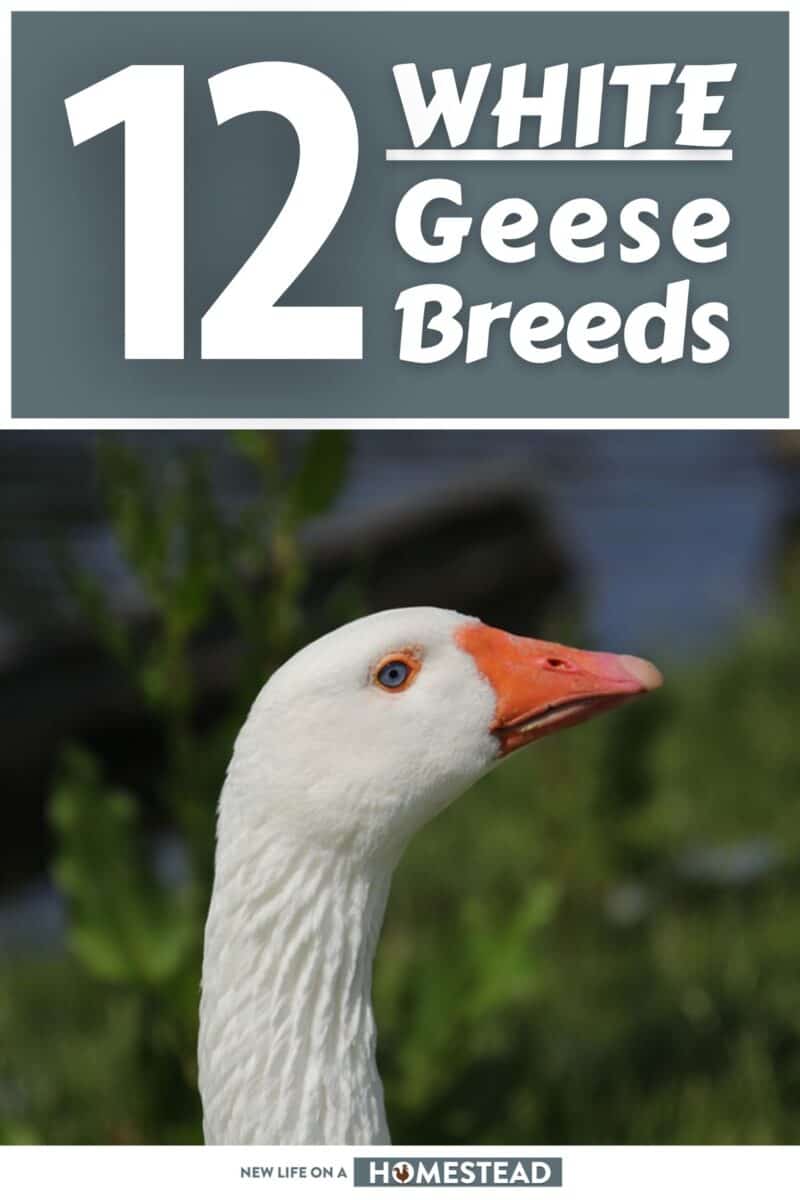
Tom has lived and worked on farms and homesteads from the Carolinas to Kentucky and beyond. He is passionate about helping people prepare for tough times by embracing lifestyles of self-sufficiency.
